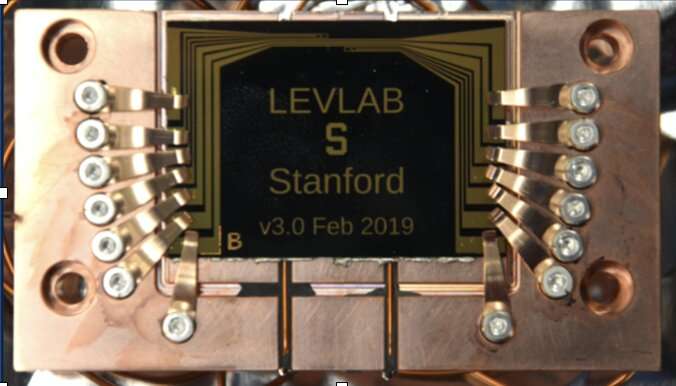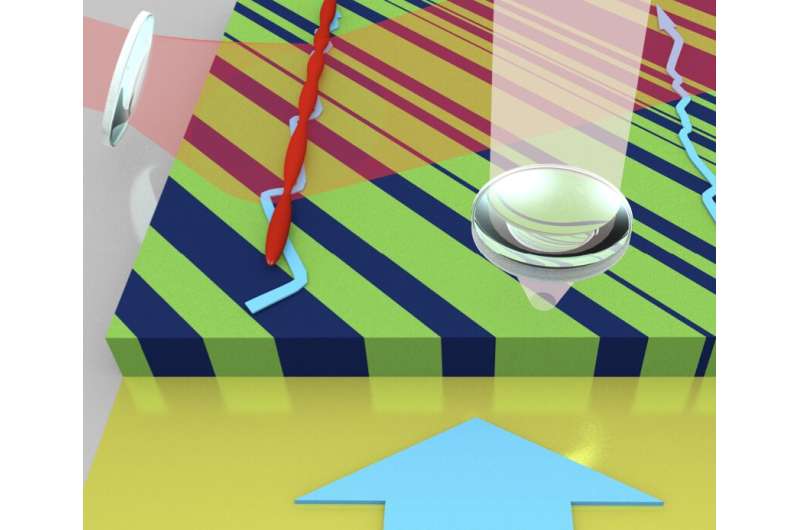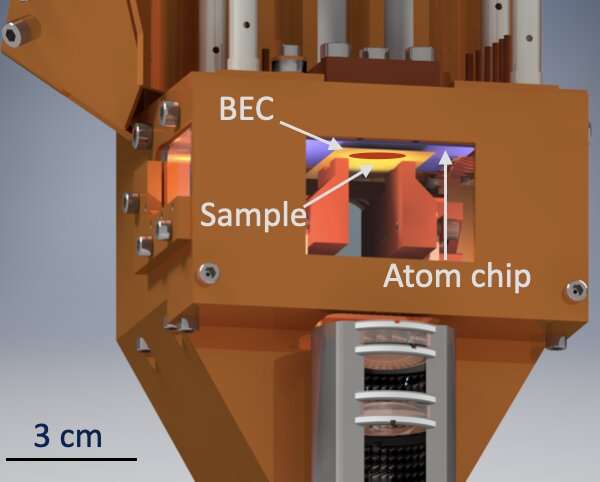Credit: Yang et al.
Researchers at Stanford University have recently carried out an in-depth study of nematic transitions in iron pnictide superconductors. Their paper, published in Nature Physics, presents new imaging data of these transitions collected using a microscope they invented, dubbed the scanning quantum cryogenic atom microscope (SQCRAMscope).
"We invented a new type of scanning probe microscope a few years ago," Benjamin L. Lev, the researcher who led the study, told Phys.org. "One can think of it like a normal optical microscope, but instead of the lens focused on some sample slide, the focus is on a quantum gas of atoms that are levitated near the sample."
In the new microscope invented by Lev and his colleagues, atoms are levitated from an 'atom chip' trapping device using magnetic fields, until they are merely a micron above the sample slide. These atoms can transduce the magnetic fields that emanate from the sample into the light collected by the microscope's lens. As a result, SQCRAMscope can be used to image magnetic fields.
"The atoms we use are ultracold and in a quantum state: they have near absolute zero temperature and are among the coldest gases in the known universe," Lev said. "As such, they serve as the best micron-scale low-frequency magnetic field sensors. The atoms can be scanned over the material surface, allowing us to record a 2-D image of the fields nearby."
By calculating the distance between the atoms in the microscope and a material's surface, the researchers can back-out images of magnetic field sources. Magnetic field sources could, for instance, be electrons that are moving around or a general magnetization inside a material.
Imaging these sources while cooling them using a tool known as 'cryostat' could ultimately unveil new physical phenomena that occur at different phase transitions. The microscope developed by Lev and his colleagues could thus serve as a brand-new quantum sensor for imaging magnetic fields emanating from variety of materials, potentially leading to new fascinating discoveries.
"Once we demonstrated that the SQCRAMscope works, we began to search for a best first scientific use for it," Lev explained. "Iron-based (pnictide) superconductors seemed like ideal candidates, as they exhibit interesting electron transport behavior on the micron length scale at accessible temperatures."
Iron pnictide superconductors have a number of unusual and intriguing characteristics. To this day, physicists are unsure about how high-critical-temperature (high-Tc) superconductivity, such as the one observed in these materials, works. Iron-based superconductors were first uncovered around 2008. Interestingly, research revealed that they exhibited some behaviors similar to those of cuprate superconductors.
Credit: Yang et al.
"These `unconventional' superconductors (as opposed to the conventional ones like aluminum at low temperatures) famously exist in the cuprate materials, discovered in the mid 80's," Lev said. "The mechanism underlying their superconductivity remains a mystery. Researchers operating in our field hope that elucidating this mechanism will provide robust, room temperature, and ambient-pressure superconductors for use in a wide variety of technologies."
A key similarity between curprate and iron-based superconductors is that both these materials present unusual electronic phases of matter, on the warmer side of superconductivity. Two of the most renowned among these phases of matter are the 'strange metal' and the 'electron nematic' phases. The electron nematic phase is an example of a quantum liquid crystal, similar to the classic liquid crystals found in LCD displays.
"These classical crystals are nematics, meaning that the rod-like molecules all align along one direction, breaking the material's rotational symmetry," Lev said. "In other words, the molecules pick one preferred direction to point along. Condensed matter theorists in the 90's began thinking about how electrons might do the same thing. Not that electrons are anything but point-like (as far as we currently know), but that below a critical transition temperature, they would decide to preferentially flow (i.e., conduct or transport) along one particular direction in a crystal, again breaking rotational symmetry; this would show up as an anisotropy in the resistivity of the material."
While electron nematics have been consistently observed in iron-based superconductors, researchers are still unsure about the reasons why they arise and the relevance of this unique phase of matter to the lower-temperature superconducting phase. Theory has not yet definitively determined whether this phase hampers, enhances or plays little role in determining the Tc of the material's superconducting phase.
Pnictides could be ideal materials for the study of electron nematics, as electrons in them also prompt a spontaneous distortion of their crystal lattice structure. In fact, past research has found that as the electronic resistivity of these materials becomes anisotropic, their lattice distorts from a square-like to a parallelogram-like shape (i.e., from tetragonal to orthorhombic).
This transformation has two key consequences. Firstly, the resulting structural domains have a resistivity anisotropy pointing in orthogonal directions. Secondly, the fact that the lattice distortion rotates the polarization of reflected light allows one to observe these domains using optical microscopes.
"Unfortunately, the first consequence complicates transport measurements," Lev explained. "One can't just measure the resistivity anisotropy with an ohm meter because the signal averages to zero over the flipping domain structure. That's where we come in. We avoid this averaging problem by using a local probe to image the local anisotropy domain by domain by seeing the directions in which the electrons flow by detecting the magnetic field they cast."
Lev and his colleagues were the first to successfully image the local resistivity anisotropy in iron pnictide superconductors. One of the reasons they were successful is that the probe they used can operate at elevated temperatures (~130 K), such as the ones at which this unique transition occurs.
Figure explaining how the microscope developed by the researchers works. Credit: Yang et al.
"A standard probe, such as scanning SQUID magnetometry can't really image samples at these temperatures with high resolution because the device itself will get too warm and stop working with high sensitivity," Lev said. "In contrast, our probe is just a gas of atoms that do not absorb any heat from the sample. Moreover, because the atoms are transparent to most light wavelengths, we were able to shine a light onto the surface to image these domain structures at the same time as we were taking the magnetometry scans."
By imaging the domain structures and simultaneously capturing magnetometry scans, the researchers were able to identify the exact sites they were scanning within the material and determine whether the shift in lattice structures observed in iron pnictide superconductors does indeed occur at the same critical temperature as their electronic nematicity. Using this dual probe system, Lev and his colleagues could corroborate their observations, which has never been achieved when using other probing devices.
"Our device's local imaging capability allowed us to measure a sharper electron nematic transition and see that it occurred at the same temperature as the structural transition," Lev said. "The general research community often asked whether these transitions did in fact occur at the same temperature, and we showed that indeed they do, at least on the micron—to—tens-of-micron length scale."
The new microscope designed by Lev and his colleagues uses a Bose-Einstein condensate, which has a sensitivity that does not depend on the temperature of the sample that is being analyzed. In addition to its dual probe function, the microscope can thus collect highly precise measurements at anything from room to cryogenic temperatures, in a non-invasive way.
The recent study carried out by Lev and his colleagues has a number of important implications. Most notably, it demonstrates, for the very first time, the potential of the researchers' SQCRAMscope for studying physical phenomena.
Using the SQCRAMscope, the researchers were able to collect the first local images of nematic transitions in iron pnictide superconductors. These images offer new valuable insight about how and when these transitions take place. In their next studies, the researchers plan to use their quantum sensor to investigate nematicity further, as well as to explore physical phenomena in other complex quantum materials.
"We have compiled a long list of exciting materials to study now that the SQCRAMscope is fully operational," Lev said. "These either exhibit topologically protected electron transport or are strongly correlated (i.e., the electrons interact and move in a complicated dance with each other, with the consequence that at least some aspects of their physics are often still a mystery)."
More information: Fan Yang et al. Nematic transitions in iron pnictide superconductors imaged with a quantum gas, Nature Physics (2020). DOI: 10.1038/s41567-020-0826-8
Fan Yang et al. Scanning Quantum Cryogenic Atom Microscope, Physical Review Applied (2017). DOI: 10.1103/PhysRevApplied.7.034026
Journal information: Nature Physics
© 2020 Science X Network


























